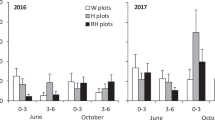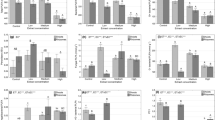Abstract
Gallic acid has been reported to be responsible for the invasive success of nonnative genotypes of Phragmites australis in North America. We have been unable to confirm previous reports of persistent high concentrations of gallic acid in the rhizosphere of invasive P. australis, and of high concentrations of gallic acid and gallotannins in P. australis rhizomes. The half-life of gallic acid in nonsterile P. australis soil was measured by aqueous extraction of soils and found to be less than 1 day at added concentrations up to 10,000 μg g−1. Furthermore, extraction of P. australis soil collected in North Carolina showed no evidence of gallic acid, and extractions of both rhizomes and leaves of samples of four P. australis populations confirmed to be of invasive genotype show only trace amounts of gallic acid and/or gallotannins. The detection limits were less than 20 μg gallic acid g−1 FW in the rhizome samples tested, which is approximately 0.015 % of the minimum amount of gallic acid expected based on previous reports. While the occurrence of high concentrations of gallic acid and gallotannins in some local populations of P. australis cannot be ruled out, our results indicate that exudation of gallic acid by P. australis cannot be a primary, general explanation for the invasive success of this species in North America.





Similar content being viewed by others
References
Agrell, J., McDonald, E. P., and Lindroth, R. L. 2000. Effects of CO2 and light on tree phytochemistry and insect performance. Oikos 88:259–272.
Bains, G., Kumar, A. S., Rudrappa, T., Alff, E., Hanson, T. E., and Bais, H. P. 2009. Native plant and microbial contributions to a negative plant-plant interaction. Plant Physiol. 151:1699–1700.
Barto, E. K., Hilker, M., Müller, F., Mohney, B. K., Weidenhamer, J. D., and Rillig, M. C. 2011. The fungal fast lane: Common mycorrhizal networks extend bioactive zones of allelochemicals in soils. PLoS One 6:e27195.
Bertin, C., Harmon, R., Akaogi, M., Weidenhamer, J. D., and Weston, L. A. 2009. Assessment of the phytotoxic potential of m-tyrosine in laboratory soil bioassays. J. Chem. Ecol. 35:1288–1294.
Blair, A. C., Hanson, B. D., Brunk, G. R., Marrs, R. A., Westra, P., Nissen, S. J., and Hufbauer, R. A. 2005. New techniques and findings in the study of a candidate allelochemical implicated in invasion success. Ecol. Lett. 8:1039–1047.
Blair, A. C., Weston, L. A., Nissen, S. J., Brunk, G. R., and Hufbauer, R. A. 2009. The importance of analytical techniques in allelopathy studies with the reported allelochemical catechin as an example. Biol Invasions 11:325–332.
Blum, U. 1998. Effects of microbial utilization of phenolic acids and their phenolic acid breakdown products on allelopathic interactions. J. Chem. Ecol. 24:685–708.
Blum, U., Staman, K. L., Flint, L. J., and Shafer, S. R. 2000. Induction and/or selection of phenolic acids-utilizing bulk-soil and rhizosphere bacteria and their influence on phenolic acid phytotoxicity. J. Chem. Ecol. 26:2059–2078.
Callaway, R. M. and Ridenour, W. M. 2004. Novel weapons: Invasive success and the evolution of increased competitive ability. Front. Ecol. Environ. 2:436–443.
Cecchi, A., Koskinen, W., Cheng, H., and Haider, K. 2004. Sorption–desorption of phenolic acids as affected by soil properties. Biol Fertil. Soils. 39:235–242.
Choi, S.-E., Yoon, J.-H., Choi, H.-K., and Lee, M.-W. 2009. Phenolic compounds from the root of Phragmites communis. Chem. Nat. Compd. 45:893–895.
Chung, I. M., Kim, K. H., Ahn, J. K., Chun, S. C., Kim, C. S., Kim, J. T., and Kim, S. H. 2002. Screening of allelochemicals on barnyardgrass (Echinochloa crus-galli) and identification of potentially allelopathic compounds from rice (Oryza sativa) variety hull extracts. Crop. Prot. 21:913–920.
Dalton, B. R., Blum, U., and Weed, S. B. 1989. Plant phenolic acids in soils: Sorption of ferulic acid by soil and soil components sterilized by different techniques. Soil Biol. Biochem. 21:1011–1018.
Doyle, J. J. and Doyle, J. L. 1987. A rapid DNA isolation procedure for small quantities of fresh leaf tissue. Phytochem. Bull. 19:11–15.
Gaspar, E. M. S. M. and Lucena, A. F. F. 2009. Improved HPLC methodology for food control—furfurals and patulin as markers of quality. Food Chem. 114:1576–1582.
Gross, E. M. 2003. Differential response of tellimagrandin II and total bioactive hydrolysable tannins in an aquatic angiosperm to changes in light and nitrogen. Oikos 103:497–504.
Hagerman, A. E., Robbins, C. T., Weerasuriya, Y., Wilson, T. C., and McArthur, C. 1992. Tannin chemistry in relation to digestion. J. Range Manage. 45:57–62.
Halvorson, J. J., Gollany, H. T., Kennedy, A. C., Hagerman, A. E., Gonzalez, J. M., and Wuest, S. B. 2012. Sorption of tannin and related phenolic compounds and effects on extraction of soluble-N in soil amended with several carbon sources. Agriculture 2:52–72.
Harborne, J. B. 1984. Phytochemical Methods: A Guide to Modern Methods of Plant Analysis, 2nd ed. Chapman and Hall, London.
Hendricks, L. G., Mossop, H. E., and Kicklighter, C. E. 2011. Palatability and chemical defense of Phragmites australis to the marsh periwinkle snail Littoraria irrorata. J. Chem. Ecol. 37:838–845.
Inderjit 2005. Soil microorganisms: An important determinant of allelopathic activity. Plant Soil 274:227–236.
Inderjit, Bajpai, D., and Rajeswari, M. S. 2010. Interaction of 8-hydroxyquinoline with soil environment mediates its ecological function. PLoS One 5:e12852.
Kaur, H., Kaur, R., Kaur, S., Baldwin, I. T., and Inderjit 2009. Taking ecological function seriously: Soil microbial communities can obviate allelopathic effects of released metabolites. PLoS One 4:e4700.
Kinraide, T. B. and Hagerman, A. E. 2010. Interactive intoxicating and ameliorating effects of tannic acid, aluminum (Al3+), copper (Cu2+), and selenate (SeO4 2−) in wheat roots: A descriptive and mathematical assessment. Physiol. Plant. 139:68–79.
Krogh, S. S., Mensz, S. J. M., Nielsen, S. T., Mortensen, A. G., Christophersen, C., and Fomsgaard, I. S. 2006. Fate of benzoxazinone allelochemicals in soil after incorporation of wheat and rye sprouts. J. Agric. Food Chem. 54:1064–1074.
Laponen, J., Ossipov, V., Lempa, K., Haukioja, E., and Pihlaja, K. 1998. Concentrations and among-compound correlations of individual phenolics in white birch leaves under air pollution stress. Chemosphere 37:1445–1456.
Li, F.-M. and Hu, H.-Y. 2005. Isolation and characterization of a novel antialgal allelochemical from Phragmites communis. Appl. Environ. Microbiol. 11:6545–6553.
Mal, T. K. and Narine, L. 2004. The biology of Canadian weeds. 129. Phragmites australis (Cav.) Trin. ex Steud. Can. J. Plant. Sci. 84:365–396.
Ramírez-Jiménez, A., García-Villanova, B., and Guerra-Hernández, E. 2000. Hydroxymethylfurfural and methylfurfural content of selected bakery products. Food Res. Int. 33:833–838.
Reigosa, M. J., Souto, X. C., and González, L. 1999. Effect of phenolic compounds on the germination of six weeds species. Plant. Growth. Regul. 28:83–88.
Rudrappa, T. and Bais, H. P. 2008. Genetics, novel weapons and rhizospheric microcosmal signaling in the invasion of Phragmites australis. Plant Signal. Behav. 3:1–5.
Rudrappa, T., Bonsall, J., Gallagher, J. L., Seliskar, D. M., and Bais, H. P. 2007. Root-secreted allelochemical in the noxious weed Phragmites australis deploys a reactive oxygen species response and microtubule assembly disruption to execute rhizotoxicity. J. Chem. Ecol. 33:1898–1918.
Rudrappa, T., Choi, Y. S., Levia, D. F., Legates, D. R., Lee, K. H., and Bais, H. P. 2009. Phragmites australis root secreted phytotoxin undergoes photo-degradation to execute severe phytotoxicity. Plant Signal. Behav. 4:506–513.
Salminen, J.-P., Ossipov, V., Haukioja, E., and Pihlaja, K. 2001. Seasonal variation in the content of hydrolysable tannins in leaves of Betula pubescens. Phytochemistry 57:15–22.
Saltonstall, K. 2002. Cryptic invasion by a non-native genotype of the common reed, Phragmites australis, into North America. Proc. Natl. Acad. Sci. USA 99:2445–2449.
Saltonstall, K. 2003. A rapid method for identifying the origin of North American Phragmites populations using RFLP analysis. Wetlands 23:1043–1047.
Schmidt, S. K. 1988. Degradation of juglone by soil bacteria. J. Chem. Ecol. 14:1561–1571.
Schmidt, M. A., Halvorson, J. J., Gonzalez, J. M., and Hagerman, A. E. 2012. Kinetics and binding capacity of six soils for structurally defined hydrolysable and condensed tannins and related phenols. J Soils. Sediments. 12:366–375.
Sosa, T., Valares, C., Alías, J. C., and Lobón, N. C. 2010. Persistence of flavonoids in Cistus ladanifer soils. Plant Soil 337:51–63.
Weidenhamer, J. D. and Romeo, J. T. 1989. Allelopathic properties of Polygonella myriophylla: Field evidence and bioassays. J. Chem. Ecol. 15:1957–1969.
Weidenhamer, J. D. and Romeo, J. T. 2004. Allelochemicals of Polygonella myriophylla: Chemistry and soil degradation. J. Chem. Ecol. 30:1061–1078.
Weidenhamer, J. D., Hartnett, D. C., and Romeo, J. T. 1989. Density-dependent phytotoxicity: Distinguishing resource competition and allelopathic interference in plants. J. App. Ecol. 26:613–624.
Weidenhamer, J. D. and Romeo, J. T. 2005. Allelopathy as a mechanism for resisting invasion: The case of Polygonella myriophylla, pp. 167–177, in Inderjit (ed.) Invasive Plants: Ecological and Agricultural Aspects. Birkhauser Verlag, Switzerland.
Acknowledgments
This work was supported by a grant from the National Science Foundation (CHE/MRI-0922921) for the JEOL ECS-400 NMR spectrometer used in these studies, and by the Choose Ohio First Scholarship program of the Ohio Board of Regents (JA). Dr. Eric Bodle and Dr. Frank Bockhoff of WIL Research (Ashland, OH) provided assistance with LC-MS analysis of 5-HMF. Dr. Soren Brauner provided technical assistance with the genotyping techniques used in this study, and Dr. Ann Hagerman advised regarding the analytical procedures for gallic acid and gallotannins. Dr. Leslie Weston and Dr. Udo Blum provided helpful comments which improved this manuscript. The Ashland University Marine Biology class (BIO 412) assisted with the collection of samples.
Author information
Authors and Affiliations
Corresponding author
Electronic supplementary material
Below is the link to the electronic supplementary material.
Supplemental Fig. 1
Mass spectrum of 5-hydroxymethylfurfural isolated from Phragmites australis extract (A) compared to NIST library spectrum (B). (JPEG 56 kb)
High Resolution Image
(TIFF 178 kb)
Supplemental Fig. 2
Mass spectrum of suspected 2-methoxy-4-vinylphenol isolated from Phragmites australis extract (A) compared to NIST library spectrum (B). (JPEG 54 kb)
High Resolution Image
(TIFF 173 kb)
Rights and permissions
About this article
Cite this article
Weidenhamer, J.D., Li, M., Allman, J. et al. Evidence Does not Support a Role for Gallic Acid in Phragmites australis Invasion Success. J Chem Ecol 39, 323–332 (2013). https://doi.org/10.1007/s10886-013-0242-y
Received:
Revised:
Accepted:
Published:
Issue Date:
DOI: https://doi.org/10.1007/s10886-013-0242-y




